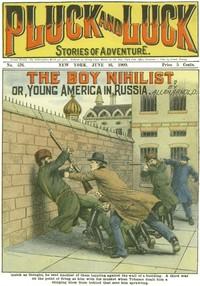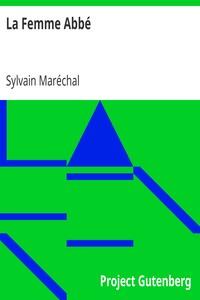Read this ebook for free! No credit card needed, absolutely nothing to pay.
Words: 74389 in 19 pages
This is an ebook sharing website. You can read the uploaded ebooks for free here. No credit cards needed, nothing to pay. If you want to own a digital copy of the ebook, or want to read offline with your favorite ebook-reader, then you can choose to buy and download the ebook.


: Lippincott's Magazine of Popular Literature and Science Volume 11 No. 26 May 1873 by Various - Science Periodicals; Literature Modern 19th century Periodicals Lippincott's Magazine
LIPPINCOTT'S MAGAZINE
MAY, 1873.
Transcriber's Note: Minor typos have been corrected and footnotes moved to the end of the article.
THE ROUMI IN KABYLIA.
THIRD PAPER.
But the next morning, after the richest and most assiduous entertainment, we see the little daughter of the amin playing in the court, attended by a negress. The child-language is much the same in all nations, and in five minutes, in this land of the Barbarians, on this terrible rock, we are pleasing the infant with wiles learnt to please little English-speaking rogues across the Atlantic.
The amin's daughter, a child of six years, forms with her slave a perfect contrast. She is rosy and white, her mouth is laughing, her peeping eyes are laughing too. What strikes us particularly is the European air that she has, with her square chin, broad forehead, robust neck and sturdy body. A glance at her father by daylight reveals the same familiar type. Take away his Arab vestments, and he would almost pass for a brother of Heinrich Heine. His child might play among the towers of the Rhine or on the banks of the Moselle, and not seem to be outside her native country. We have here, in a strong presentment, the types which seem to connect some particular tribes of the Kabyles with the Vandal invaders, who, becoming too much enervated in a tropical climate to preserve their warlike fame or to care for retiring, amalgamated with the natives. The inhabitants on the slopes of the Djordjora, reasonably supposed to have descended from the warriors of Genseric, build houses which amaze the traveler by their utter unlikeness to Moorish edifices and their resemblance to European structures. They make bornouses which sell all over Algeria, Morocco, Tunis and Tripoli, and have factories like those of the Pisans in the Middle Ages.
Contrast the square and stolid Kabyle head shown in the engraving on this page with the type of the Algerian Arab on page 494. The more we study them, or even rigidly compare our Arab with the amin of Kalaa, the more distinction we shall see between the Bedouin and either of his Kabyle compatriots. The amin, although rigged out as a perfect Arab, reveals the square jaw, the firm and large-cut mouth, the breadth about the temples, of the Germanic tribes: it is a head of much distinction, but it shows a large remnant of the purely animal force which entered into the strength of the Vandals and distinguished the Germans of Caesar's day. As for the Kabyle of more vulgar position, take away his haik and his bornouse, trim the points of his beard, and we have a perfect German head. Beside these we set a representative Arab head, sketched in the streets of Algiers. See the feline characteristics, the pointed, drooping moustache and chin-tuft, the extreme retrocession of the nostrils, the thin, weak and cruel mouth, the retreating forehead, the filmed eye, the ennui, the terrestrial detachment, of the Arab. He is a dandy, a creature of alternate flash and dejection, a wearer of ornaments, a man proud of his striped hood and ornamental agraffes. The Kabyle, of sturdier stuff, hands his ragged garment to his son like a tattered flag, bidding him cherish and be proud of the rents made by Roumi bayonets.
It must be admitted that the Kabyles, with a thousand faults, are far from the fatalism, the abuse of force and that merging of individualism which are found with the Islamite wherever he appears. Whence, then, have come these more humane tendencies, charitable customs and movements of compassion? There are respectable authorities who consider them, with emotion, as feeble gleams of the great Christian light which formerly, at its purest period, illuminated Northern Africa.
Our final inference, then, is, that the Kabyles preserve strong traces of certain primitive customs, which in certain cases are attributable to a Christian origin.
A true city of romance, a Venice isolated by waves of mountains, and built upon piles whose beams are of living crystal, Kalaa, all but inaccessible, attracts the tourist as the roc's egg attracted Aladdin's wife. For ages it has been a city of refuge, a sanctuary for person and property in a land of anarchy. Nowhere else are the proud Kabyles so skillful and industrious--nowhere else are their women so much like Western women in beauty and freedom.
It is a small Moorish structure, with two stone pilasters supporting a pointed arch. In the centre is an inscription forbidding to the pious admirers of the marabout the use of the fountain while a drop remains in the Hamadouch. To assist their fidelity, the spring is effectually closed except when all other sources have peremptorily failed, in the united opinion of three amins . When the amins give permission the chains which restrain the mechanism are taken off, and the conduits are opened by means of iron handles operating on small valves of the same metal. In the great droughts the fountain of Marabout Yusef-ben-Khouia may be seen surrounded with a throng of astute, white-nosed asses, waiting in philosophic calm amid the excitement and struggle of the attendant water-bearers.
Free books android app tbrJar TBR JAR Read Free books online gutenberg
More posts by @FreeBooks


: Princo Vanc' by Bates Arlo Putnam Eleanor Harris Herbert Translator - Fantasy literature; Children Conduct of life Juvenile fiction; Fairies Juvenile fiction; Princes Juvenile fiction Esperanto







